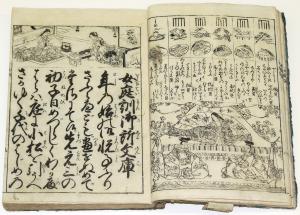Home Education Palace Collection for Girls (Onna Teikin Gosho Bunko)
Painted by Shimokōbe Shūsui 1767 (Meiwa 4) Inoue Collection 1864
Teikun means training or education in the home and this book was used as an instructional text for girls in small private temple schools called terakoya and other schools in the Edo period (1603 to 1867). Some female teachers taught Genji Monogatari, the "Tale of Genji" in Terakoya for girls.
Reading the "Tale of Genji" was necessary for cultured women in those days. The novel was also frequently involved in the textbooks of elementary education called ōraimono, and rather than simply the story itself, what was said to have been often discussed were specific topics regarding the general knowledge about the "Tale of Genji", including chapter names, chapter related poems called waka, Genji-kō (Genji incense) and the background to the story.
In addition to the education related contents, which were mainly written as a form of letters, as ōraimono for girls, it contains, in the beginning of the book, the brief personal history of the authorMurasaki Shikibu and the circumstances involved during the writing of the story, as "Murasaki Shikibu Ishiyama Ki" with the picture of Ishiyama-dera temple located in Ōtsu city, Shiga prefecture, where Shikibu is said to have worked out the plot of the story.
The Genji-kō (Genji Incense) is one of Kumi-Kō, where players make a guess at the incense name while burning various fragrant woods. Fifty-two varieties of patterns are made by expressing the combination of incense by five vertical lines and connecting the same incenses by horizontal lines and then these patterns are associated with 52 chapters of the Genji's 54 chapters excluding the first chapter of "Kiritsubo (the emperor's name)" and the last chapter of "Yume no Ukihashi (The Floating Bridge of Dreams)." The patterns became common to the public and were used in a wide variety of fields ranging from designs of Kimono or art crafts to the patterns of sweets.


